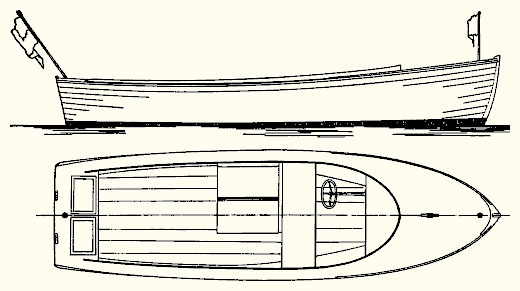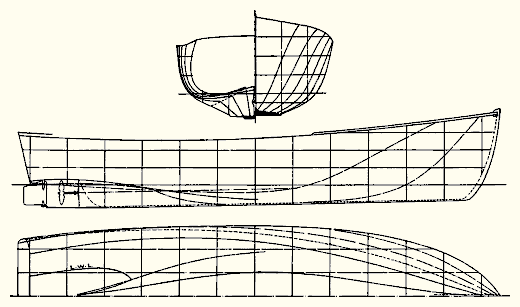

Everhope -� there's a name that epitomizes the spirit of your true fisherman; and here, by way of passing, is a boat excellently adapted to fulfill the fondest desires of those countless legions who follow the footsteps of Isaac Walton.

Everhope is 20 feet long; 18 feet, 9 inches on the water line; 6 feet in breadth; and draws only 1 foot of water. This is loaded draft. The freeboard at the bow is 3 feet, at the lowest point 1 foot 11 inches, and at the stern 2 feet, 1 inch. The boat is lightly built and not too heavy to be carried around on a trailer in quest of well stocked fishing grounds.
The arrangement of the little boat shows the motor installed under a box amidships; the box does not extend full across the cockpit and the passageway left is handy for getting forward or aft. In addition to the motor there is welcome room for starting battery, exhaust pipe, tools, etc. The cockpit is 8 feet, 2 inches long providing excellent room for chairs if these are desired. Twin fish boxes in the after deck are provided. The seat for the helmsman is forward of the motor box and extends full across the boat. Regulation bulkhead steerer is shown which is mounted on the forward bulkhead. The old fashioned tiller lines and quadrant are recommended for controlling the rudder; the newer gear steerers are, however, equally good, but cost more.

Her design is a development of those very practical and useful fishing boats that have been used for half a century or more off the sandy beach of New Jersey; flat on the bottom to facilitate beaching; round on the topsides and with generous flare to create seaworthiness; excessive freeboard to ward off spray; and enough sheer to make them look like boats!
In this particular edition, however, there is an alteration in the after sections. This permits shallow draft with perfect protection to both rudder and propeller. A brief study of the lines will show how the matter works out. Somehow this form is very efficient and with a given amount of power will be much faster than the usual motor boat underwater form. Among reasons for this efficiency is the nearly level propeller shaft; the ease and evenness with which the water flows into the propeller; and the straight flat keel.
The flat straight bottom will be particularly appreciated in the process of moving the boat from a trailer and getting it in and out of the water. The boat will always rest on an even keel and can be easily moved on iron pipe rollers.
Everhope does not require excessive power. Use a motor developing about 22 h.p. at 1,800 r.p.m. This will provide speeds up to 17 1/2 miles per hour. The maximum speed that can be expected with a motor of about 45 h.p. at 3,500 is 21 miles an hour.
Fish always seem to gather in places that do not suit the more usual types of motor boats; either the water is very shallow, or a ledge makes out and the best fishing is at the tip end of this, or the tide flows rapidly and kicks up a bad chop, or the fishing ground is many miles away and so the boat must be very fast thus saving time en-route and then at the same time must be able to proceed very slowly and handle quickly for trolling. I do not know how many different kinds of fishing boats I have designed; there seems to be no end to the subject. Everhope should be able to satisfy the requirements of many fishermen; but she will not answer every service required of fishermen. There is no one boat versatile enough for this tremendously wide duty.